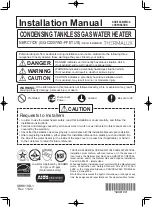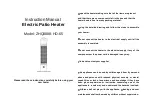
14
PLEASE NOTE: FVI12 IS FOR INDOOR PERMANENT INSTALLATIONS ONLY. THIS MANUAL AND ALL ECCOTEMP CONTENT IS SUBJECT TO CHANGE WITHOUT
NOTICE. PLEASE VISIT WWW.ECCOTEMP.COM/SUPPORT FOR MORE INFORMATION.
Support:
Eccotemp.com/help-desk
Shop Online:
Eccotemp.com/products
Store Locator:
Eccotemp.com/locator
Phone: 866-356-1992 | Email: [email protected] | Address: 315 - A Industrial RD Summerville, SC 29483
English
WARNING:
Never use an open
flame to test for gas
leaks, as property
damage, personal
injury, or death
could result.
The water heater and its gas connections must be leak tested at normal operating
pressures before it is placed in operation.
• Turn on the gas shut-off valve(s) to the water heater.
• Use a commercial leak detector or soapy water solution to test for
leaks at all connections and fittings. Bubbles indicate a gas leak that
must be corrected.
All connections should also be leak tested after the water heater is placed in operation.
Pressure Testing the Gas Supply System
WARNING: Install a gas pressure regulator, in the gas supply line, which does not exceed the
maximum supply pressure. DO NOT use an industrial type gas regulator.
The water heater must be isolated from the gas piping system by closing the manual gas shut-off valve during
any pressure testing of the gas supply piping at pressures equal to or less than 1/2 psi (14’w.c.) .
Ratings of gas appliances are based on sea level operation and need not be changed for installations at
elevations up to 2,000 ft. This water heater is not recommended for elevations in excess of 2,000 ft.
A new pressure relief valve, complying with the Standard for relief Valves and Automatic Gas Shut-Off Devices
for Hot Water Supply Systems, ANSI Z21.22, must be installed at the hot water outlet connection of the water
heater at the time of installation. Local codes shall govern the installation of relief valves. Pressure relief valves
are not included with your water heater but are available for purchase at www.eccotemp.com
For safe operation of the water heater, be sure that:
• The pressure rating of the relief valve must not exceed 150 psi, the maximum working pressure of
the water heater as marked on the rating plate.
• The BTUH rating of the relief valve must equal or exceed the BTUH input of the water heater as
marked on its rating plate.
• No valve of any type should be installed between the relief valve and the water heater.
• Discharge from the relief valve should be piped to a suitable drain to eliminate potential water
damage. Piping used should be of a type approved for the distribution of hot water.
• Hot and cold water lines should be insulated up to the water heater.
• The discharge line must be NO SMALLER than the outlet of the valve and must pitch downward to
allow complete drainage (by gravity) of the relief valve and discharge line.
• The end of the discharge line should not be threaded or concealed and should be protected from
freezing. No valve of any type, restriction or reducer coupling should be installed in discharge line.
NOTICE: The diagram below illustrates a pressure only relief valve. If local codes require a combination
temperature and pressure relief valve be installed, an extension piece may be needed.
NOTICE:
Local codes govern the installation of relief valves. If
local codes require that a temperature and pressure relief valve
should be installed the manufacturer recommends a type 40XL
Watts T&P relief valve or an equivalent model be used.
NOTICE:
Manual operation of relief valves should be
performed at least once a year. Turn off the electrical power
and gas shutoff valve. Lift and release lever on the relief valve
and check the manual operation of the relief valve. You should
take precaution to avoid contact with the hot water coming out
of the relief valve and to prevent water damage.
NOTICE:
If the relief valve on the system discharges periodically,
this may be due to thermal expansion in a closed water supply
system. Contact the water supplier or local plumbing inspector
on how to correct this situation. Do not plug the relief valve.
Relief Valve
Leak Testing
High Altitude
Installation
















































